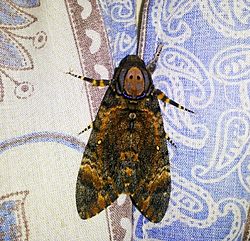Acherontia styx
| Acherontia styx | |
|---|---|
 |
|
| Acherontia styx, adult | |
| Scientific classification | |
| Kingdom: | Animalia |
| Phylum: | Arthropoda |
| Class: | Insecta |
| Order: | Lepidoptera |
| Family: | Sphingidae |
| Genus: | Acherontia |
| Species: | A. styx |
| Binomial name | |
|
Acherontia styx Westwood, 1847 |
|
| Synonyms | |
|
|
Acherontia styx, the lesser death's head hawkmoth or bee robber, is a Sphingid moth found in Asia, one of the three species of death's-head hawkmoth. It is very fond of honey and bee keepers have reported finding dead moths in their hives as a result of bee stings. They can mimic the scent of bees so that they can enter a hive unharmed to get honey. Their tongue, which is stout and very strong, enables them to pierce the wax cells of the beehive and suck the honey out. They are also known to be a pest of yuzu (Citrus junos) in South Korea, using their tongue to pierce and damage the fruit.
This species is similar to the European A. atropos but differs in having two medial bands on the underside of the forewing, instead of one, and usually no dark bands across the ventral surface of the abdomen. The skull-like marking is darker and there is a faint blue tornal dot enclosed by a black submarginal band on the hindwing upperside. The forewing discal spot (stigma) is orange; in A. atropos it is usually white.
There are two described subspecies, A. s. styx, and A. s. medusa Moore, but they intergrade widely, and authorities presently consider that A. s. medusa is just a wet zone/season form, and not taxonomically distinct.
A. s. styx male
A. s. styx male underside
A. s. styx female
A. s. styx female underside
A. s. medusa dorsal side
A. s. medusa underside
Caterpillar
In, The Fauna of British India Including Ceylon and Burma, Moths Vol-1, the species described as follows.
Eggs are laid primarily on Bignoniaceae, Fabaceae, Oleaceae, Pedaliaceae, Solanaceae and Verbenaceae. In India, the larvae sometimes occur in such numbers as to cause serious damage to crops, such as Sesamum indicum. Mature larvae can attain 120mm, and come in green, yellow, or brown color forms. Larvae closely resemble those of A. atropos except that the dark blue dorsal speckling is more pronounced on the anterior half of each abdominal segment, and the tail horn is less curved and lacks a reflexed tip. Pupation occurs in an underground chamber, excavated less than 10 cm below the surface of the soil.
...
Wikipedia
